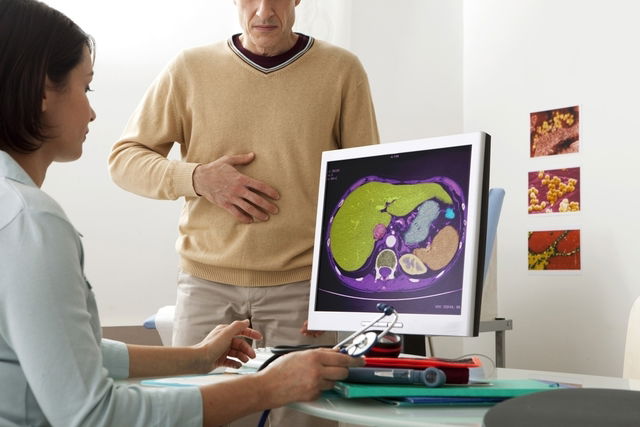Chronic liver inflammation is characterized by the formation of nodules and fibrous connective tissue within the liver, which hinder this organ’s function.
Usually, liver inflammation is associated with a more advanced stage of a hepatic condition, such as hepatitis or fatty liver disease.. In addition to these problems, inflammation can also occur as a result of excessive alcohol consumption, extensive medication use, and even viral infections.
Chronic liver inflammation, or cirrhosis, is not curable therefore treatment is normally aimed at managing some of the symptoms and preventing the condition from getting worse. Treatment can include some dietary changes as well as medication. In more serious cases, surgery may also be necessary to transplant a new liver.

Main symptoms
In an initial stage, liver inflammation does not usually cause any type of symptoms. However, as the condition worsens and progresses into cirrhosis, symptoms may start appearing. These include:
- Weakness and fatigue;
- General malaise;
- Frequent nausea;
- Loss of appetite;
- Red patches on the skin;
- Weight loss.
In more advanced stages of cirrhosis, it's common to observe other signs such as yellow skin and eyes, bloated stomach, dark urine, white feces and itchiness in the whole body.
If you identify a symptom that can indicate some type of liver problem, it's important to visit a hepatologist or a G.P. Try our online symptom checker to assess for your risk of liver disease.
Possible causes
There are several causes for liver inflammation, but the most common ones include:
1. Viral hepatitis
Hepatitis B and C are usually caused by viruses that can be transmitted through sexual intercourse or by sharing of contaminated objects, such as needles, syringes, manicure pliers, or contaminated tattoo devices.
These two types of hepatitis affect the liver cells, and if they are not treated early, can cause chronic liver inflammation, leading to cirrhosis.
2. Alcohol abuse
Alcohol abuse can cause immediate consequences for the body such as difficulty maintaining balance and loss of coordination. Meanwhile, if consumption happens frequently and in amounts higher than 60g of alcohol per day, in men, or 20 g, in women, this can lead to hepatic cirrhosis.
3. Metabolic disorders
Some metabolic disorders can lead to liver inflammation and cirrhosis, such as Wilson's disease. This is a rare, genetic disease that does not have a cure. It is characterized by the body's inability to metabolize copper, which accumulates in several organs (especially the brain and liver), causing serious damage to those organs.
4. Fatty liver disease
Fatty liver disease, known scientifically as hepatic steatosis, is a condition in which there is an accumulation of fat in the liver due to bad dietary habits. If left untreated, fatty liver can cause chronic inflammation of the liver, increasing the risk of cirrhosis. Read about how diet can affect fatty liver.
5. Medication
Some remedies, if used in excess or very regularly, can cause liver inflammation, contributing to cirrhosis. Some types of medication that can lead to the development of hepatic cirrhosis include isoniazide, nitrofurantoin, amiodarone, methotrexate, chlorpromazine, and diclofenac sodium.
6. Chronic cholestasis
Chronic cholestasis is a condition in which the bile cannot be excreted from the liver to the intestine. This can happen due to tumors or gallstones obstructing the bile ducts or even due to a deficiency in the production of bile. Because of this bile build-up, chronic cholestasis can lead to hepatic cirrhosis.
Also recommended: Liver Pain: Symptoms, Causes & Treatment Options tuasaude.com/en/liver-painHow to diagnose liver inflammation
Diagnosis for liver inflammation or cirrhosis starts with an evaluation of symptoms, daily habits, and health history. In addition, lab tests are usually requested to assess liver function, the kidneys and the blood’s ability to clot. The doctor may also order some serologic tests to identify possible viral infections.
The main lab tests that tend to be requested include ALT, AST and Gamma-glutamyl transferase (GGT) blood tests. These tests check hepatic enzyme levels, which become more elevated with liver disease. Learn more about AST and ALT tests.
Doctors can also request a CT exam or a MRI to assess the liver and the abdominal region, in order to identify affected areas and to determine the need to carry out a biopsy. A liver biopsy is not done with the goal of reaching a diagnosis, but can help determine gravity, extension, and the cause of the cirrhosis.
Treatment options
Treatment for liver inflammation will differ according to its cause and severity, and it may involve suspending medication or alcohol intake. In addition, it's important to maintain a well balanced diet, that includes the consumption of fresh fruits and vegetables. Learn more about which foods are good for your liver.
Depending on the symptoms, the doctor may also prescribe the use of some medications, such as diuretics, high blood pressure remedies or creams for skin itchiness, in order to improve the patient's quality of life.
In more advanced stages, when there are many lesions to the liver, the only form of treatment may be a liver transplant, which is done by removing the affected liver and replacing it with a healthy liver from a compatible donor.
Possible complications
Possible complications of liver cirrhosis include portal hypertension, enlarged spleen, increased risk of infection, hemorrhage, accumulation of fluid in the abdomen, hepatorenal syndrome, spontaneous bacterial peritonitis or hepatic encephalopathy.
